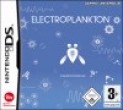Review: Electroplankton
Posted 13 Aug 2005 at 20:24 by Mark
DS Review
When news broke earlier this year about a new, quirky, music-based DS title from Nintendo, I immediately checked out the accompanying website, Electroplankton.com- and after watching a brief clip of video footage of the, er, software, I was hooked. Even then, I knew that I would appreciate Electroplankton's beautiful weirdness- you could call it love at first sight. But that would be stupid, as we're talking about a 2x1cm slab of grey plastic.
Chances are that if you've read any preview, seen any shots or watched any videos of Electroplankton in action, then you've already decided if Japanese musician Toshio Iwai's slice of leftfield music-making is for you. If you haven't, though, the first thing you need to know is that Electroplankton is not a game. Sure, it has rules. Yes, it's highly interactive. It even has different stages, of sorts. But a game, this is not. Not only that, but it is equally a world away from traditional PC-based music creation software. It's best to think of Electroplankton as a sort of a high-tech interactive 'toy' (in the best possible meaning of the word), which utilizes sound and light in aesthetically pleasing ways. This explanation doesn't really sum it up either though, as Electroplankton is gloriously genre-less, and entirely free from the predictable pigeon-holing of most other modern games. And it works marvellously. Nintendo and Iwai have fashioned a bizarre, daring, and thoroughly satisfying piece of software that stands out as one of the DS's finest.
The whole Electroplankton package screams 'style' from the moment you set your eyes on the box. From the glossy packaging (an outer cardboard box houses the standard DS case, along with a natty set of blue earphones) to the manual, which, with its beautiful illustrations, renders the language barrier irrelevant, first impressions are very good. But what of the gameplay, such as it is? Essentially, you choose from one of ten 'plankton', which are better described as 'music-based mini-games' rather than 'musical instruments'. Each one is completely different, and you'll quickly find your favourites. Some reviews have described at length the workings of each plankton in intricate detail, thereby revealing, in its entirety, everything Electroplankton has to offer. I'm not going to do that, as half the fun of Electroplankton is experimenting and exploring the various quirks with each plankton.
Suffice to say, amongst the various plankton on offer, with 'Tracy' you'll be drawing lines on the screen which reverberate with sound, with 'Hanenbow', you'll be aiming a stream of plankton at a series of leaves on a plant which create musical notes as they do so, and with 'Lumiloop' you have to furiously rotate the stylus in a circular motion to cause coloured circles emit various electronic noises. Sounds like Nintendo are completely off their rocker? Probably are.
Electroplankton isn't going to appeal to everyone. Those of us weaned on a diet of sports games with licensed soundtracks, movie licenses and generic first person shooters probably will throw it down within ten minutes, convinced they've seen it all, and move on. But that would be a shame, as Electroplankton has hidden depths. By using the DS's face buttons, music tempo can be sped up and slowed down; instruments changed, or presented with a slightly different version of the same plankton. While this isn't a title which is supposed to be played for long periods at a time, it is one which lends itself beautifully to quick bursts of play. Many a night have I put on my earphones and delved into Hanenbow, meaning to play for a minute, but only dropping the DS at 3 a.m. It really is wickedly satisfying, and oddly relaxing.
Also of interest in Electroplankton are the two microphone-based plankton, Rec-Rec and Volvoice. Using Rec-Rec, you can record up to four five-second sound samples, and play them back simultaneously. Several optional backing tracks can be selected. You wouldn't think it, but there's literally hours of fun to be had here, despite the fact that it is rather basic, and the recording quality less than stellar- although that's no fault of Electroplankton's, but rather the cheap n' cheerful nature of the DS microphone. Volvoice, meanwhile, records your voice and plays it back in a number of unusual ways (e.g sped up, backwards, and some that are just plain weird).Electroplankton makes good use of the DS's unique features- silky-smooth stylus control, use of the microphone, and a zoomed-in view of the action (such as it is) on the top screen-perhaps not particularly useful but it looks pretty nice all the same.
[pagebreak]
Normally, this is the part of a review where we would describe sound and visual quality, replayability and lifespan. But a non-game title such as Electroplankton really renders such concerns pointless. Suffice to say, Electroplankton's graphical style is simple but very clean 2D. Aurally, the stereo sound quality is amongst the DS' best, although with no 'music' to speak of apart from the sounds you yourself create, it is entirely dependent on the individual (although the watery sound on the menus is fantastically authentic). As for lifespan, Electroplankton could just be the perfect companion for your DS; perfect for a quick go when you want to play something with a bit more substance to it.
It seems likely that Electroplankton will hit European shores eventually, as an American release has been confirmed already- but I see no reason not to import. For one, text is almost completely non-existent apart from a few words explaining the function of each plankton (which you'll very quickly discover). Secondly, the Western packaging probably won't be half as attractive looking as the Japanese version. Thirdly, at just a shade over 40 euro from reliable importers like Lik-Sang, (including postage and packaging) it won't cost you any more to import it- the perfect import game, if you will.
By no means is Electroplankton flawless. Its brevity will undoubtedly rankle most that play it, as will the lack of any sort of ability to save your 'compositions'. The quality of the included earphones could also be better, but you probably already own a set, so that's hardly a problem.
Electroplankton joins the likes of the highly promising Nintendogs and the wildly popular Adult Brain Training titles in Japan as impressive examples of non-game software which are thriving like never before on the Nintendo DS. Beware the scoring box below, though. While we've applied the same scoring criteria to Electroplankton as any other title, you should take the scores below with a grain of salt. Electroplankton's value is very difficult to quantify, and on its own terms succeeds in what it set out to achieve- a 'touchable media art' piece of software (creator Toshio Iwai's words) and in that context it is difficult to find fault with it.
Electroplankton, then, a worthwhile purchase for open-minded DS owners.
N-Europe Final Verdict
A fascinating, unique piece of software that could not be realised on any other console. But it's not a game.
- Gameplay3
- Playability4
- Visuals3
- Audio4
- Lifespan3
Final Score
8
Pros
Utterly original
Great use of DS
Great import title
Cons
Not a whole lot to it
No wireless features
Minority appeal






























